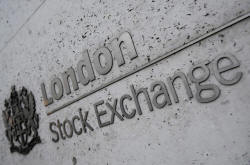Stocks stumble as U.S. yields near the 3 percent barrier
 Send a link to a friend
Send a link to a friend
 [April 23, 2018]
By Marc Jones [April 23, 2018]
By Marc Jones
LONDON (Reuters) - World stocks slipped on
Monday ahead of a blizzard of earnings from the world's biggest firms
and as wary investors watched U.S. bond yields approach peaks that have
triggered market spasms in the past.
The yield on 10-year U.S. Treasuries <US10YT=RR> hit its highest level
since January 2014 at 2.99 percent, pushing the gap - or spread - to
German bonds to the widest in 29 years and the dollar <.DXY> higher in
the process.
Traders were also getting a global round of economic surveys that should
show in the coming days if economic softness in the first quarter was
just a passing phase linked to wintery weather and the Lunar New Year
holidays in Asia.

Readings from Japan, France and Germany were all relatively reassuring.
Japan's PMI data firmed as output and domestic demand picked up, France
got help from its services sector, while Germany came in above forecast
despite weaker new orders numbers.
"It's a good reading, it's still encouraging," said Chris Williamson,
chief business economist at IHS Markit, of the combined euro zone
numbers, which he said pointed to quarterly GDP growth of 0.6 percent.
On the geopolitical front, there was plenty to digest too.
North Korea said on Saturday that it would immediately suspend nuclear
and missile tests, scrap its nuclear test site and instead pursue peace
and economic growth.
Talk of a trip by the U.S. Treasury Secretary to China also fueled hopes
that the recent trade tensions between the world's two biggest economies
may be thawing.
Oil prices edged down in the cross-currents but were not far from their
highest since late 2014. The market had wobbled on Friday when Trump
tweeted criticism of OPEC's role in pushing up global prices, but
quickly steadied.
Brent crude oil futures <LCOc1> were off 20 cents at $73.83 per barrel,
U.S. crude <CLc1> eased to $68.16. Aluminum prices leapt up again,
though, to add to this month's 25 percent surge following U.S. sanctions
on Russia's producer-giant Rusal.
"Underlying (oil market) sentiment is bullish," Saxo Bank senior manager
Ole Hansen. "And we have OPEC potentially trying to 'overtighten' the
market."

In stock markets, MSCI's world index <.MIWD00000PUS> fell 0.25 percent
after Asia <.MIAPJ0000PUS> had shed 0.5 percent overnight and Europe
then slipped 0.2 percent <.STOXX> as results from Switzerland's biggest
bank, UBS, disappointed and the rise in yields added pressure generally.
E-Mini futures for the S&P 500 <ESc1> were also pointing to a lower
start for Wall Street later.
More than 180 companies in the S&P 500 are due to report results this
week, including Amazon, Alphabet, Facebook, Microsoft, Boeing and
Chevron.
THE 3 PCT BARRIER
Of particular concern for U.S. analysts will be executives' views about
their exposure to China, amid the recent worries about a trade war.
U.S. Treasury Secretary Steven Mnuchin said on Saturday he might travel
to Beijing, a move that could ease tensions between the two supersized
economies.
"A trip is under consideration," Mnuchin said at a news conference
during the International Monetary Fund and World Bank spring meetings in
Washington.
[to top of second column] |

The London Stock Exchange Group offices are seen in the City of
London, Britain, December 29, 2017. REUTERS/Toby Melville/File Photo

"I did meet with the Chinese here. The discussions were really more around the
governor's actions at the PBOC (People's Bank of China) and certain actions
they've announced in terms of opening some of their markets, which we very much
encourage and appreciate."
Back in commodity markets, the spike in oil has driven up both market
expectations of future inflation <USIL5YF5Y=R> and long-term bond yields.
Yields on 10-year Treasuries <US10YT=RR> are at the highest now since early 2014
and again threatening the hugely important 3 percent bulwark.
The last time yields neared this number in 2013 it rocked risk appetite and sent
stocks sliding. It also came shortly before oil prices went on a mighty 75
percent tumble.
"Another $5/barrel increase in oil will be enough for U.S. 10-year yields to
threaten 3 percent. Oil is now at the cusp of levels where higher prices will
spark greater FX and broader asset market volatility," said Deutsche Bank's
macro strategist, Alan Ruskin.
Traditionally the dollar had a slight negative correlation with oil, mostly
because the dominant causation goes from dollar weakness to rising oil prices,
he added.
"If oil helps push the 10-year yield into new terrain for this cycle, this will
play at least mildly USD positive in a change of correlation."

Indeed, dealers cited widening yield differentials for the dollar's broad rally.
The gap with German bonds has touched the widest in almost three decades. On a
spot basis shorter-term U.S. 2-year yields are testing 2.5 percent <US2YT=RR>,
which is the highest since 2008.
The greenback was last at 108.215 <JPY=> having broken through major resistance
in the 107.90/108.00 zone, which has held solid since mid-February.
The dollar index powered up to 90.69 <DXY>, and further away from last week's
low at 89.229.
The euro was easier at $1.2232 <EUR=>, having repeatedly failed to break above
$1.2400 in the last couple of weeks.
Investors are awaiting the European Central Bank's policy meeting on Thursday
amid talk that policymakers feel it is still too early to announce a timetable
for winding down its bond buying.
ECB chief Mario Draghi said on Friday he was confident that the inflation
outlook has picked up, but uncertainties "warrant patience, persistence and
prudence".
(Additional reporting by Wayne Cole in Sydney and Jonathan Cable in London;
Editing by Gareth Jones)
[© 2018 Thomson Reuters. All rights
reserved.] Copyright 2018 Reuters. All rights reserved. This material may not be published,
broadcast, rewritten or redistributed.
Thompson Reuters is solely responsible for this content.
 |